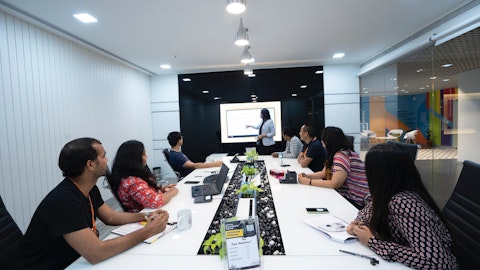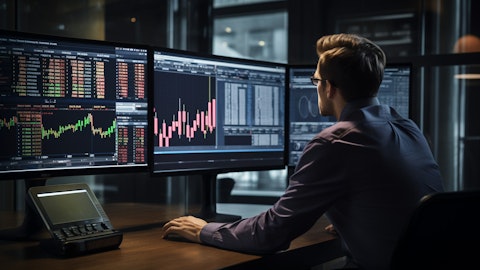Elon Musk: Yeah, I guess. Let me explain what my concern is here, which is that I see a path to creating an artificial intelligence and robotics juggernaut of truly immense capability and power. And my concern would be, I don’t want to control it. But if I have so little influence over the company at that stage that I could sort of be voted out by some sort of random shareholder advisory firm. We’ve had a lot of challenges with institutional shareholder services, ISS, I call them ISIS, and Glass Lewis, which — and there’s a lot of activists that basically infiltrate those organizations and have strange ideas about what should be done. So I want to have enough to be influential. Like, if we could do a dual-class stock, that would be ideal.
I’m not looking for additional economics. I just want to be an effective steward of very powerful technology. And the reason I just sort of roughly picked approximately 25% was that’s not so much that I can control the company, even if I go bonkers and if I’m, like, mad, they can throw me out. But it’s enough that I have a strong influence. That’s what I’m aiming for, is a strong influence, but not control. If there’s some way to achieve that that would be great.
Martin Viecha: Thank you. The next question is, what is your expectation for automotive gross margin ex-regulatory credits for the full year?
Vaibhav Taneja: Like, I said in my opening remarks, we’re focused on reducing the cost of our vehicles. This is very extensive and involved exercise whereby we look at not just the component cost, but down to the packaging used to get the materials to the production flow. Each element of the cost is scrutinized to optimize further. A few pennies saved at the subcomponent level, whether through engineering redesign or from many other things which I mentioned leads to cost reduction. This is a constant exercise and we just have to chase down every penny possible. We have a strong team which is hyper-focused on this. However, this is a very difficult thing to predict precisely because there are lots of…
Elon Musk: We don’t know. We don’t have a crystal ball, so it’s difficult for us to predict this with precision. If the interest rates come down quickly, I think margins will be good. And if they don’t come down quickly, they won’t be that good. Yeah. It’s always important to remember that the vast majority of people buying a car is about the monthly payment. It’s not that people don’t want. We have tons of — we have lots of people who want to buy our car but simply cannot afford it. And as interest rates drop and that monthly payment drops, then they’re able to afford it and they buy the car. It’s pretty straightforward and there are no tricks around to get around this.
Martin Viecha: Okay. Thank you. The next question is, does the company anticipate a 50% volume CAGR to be realized in either of 2024 or 2025? If not, why not?
Vaibhav Taneja: As we have said in our prior guidance, there will be periods where we won’t be growing at the same rate as before. We are between two major growth waves. The first one began with the global expansion of Model 3 and Y, and we believe the next one will be initiated with the next generation platform. In 2024, our volume growth will be lower, as we have said, because we are trying to focus the team on the launch of the next generation vehicle.
Martin Viecha: All right. Thank you very much. The next question is from Michael. When will Tesla start construction on the Giga Nevada expansion and Giga Mexico, and when can we expect each of these to produce their first products such as 4680 cell, Semi, and next-gen vehicles?
Karn Budhiraj: We have recently broken ground for the next phase of Giga Nevada expansion to incorporate Semi and other projects. But as said earlier, as regarding Mexico, we want to first demonstrate success with the next-generation platform in Austin before we start construction. Therefore, we have started the long lead work to get the basics ready and plan to follow our recipe from the 3/Y ramp with Shanghai, where we started with learnings from Fremont and ramp really quickly.
Elon Musk: Yeah, exactly. It’s important to emphasize that I mean, Model 3 production was three years of hell, I’ve said it before, some of the really worst years of my life, frankly. I still have mental scar tissue from those three years, as do many. And then Model Y was somewhat of a variant on Model 3. So a much easier situation. And then we were able to actually do an improved — slightly improved versions of, in some cases, significantly improved versions of the Model Y production line in Shanghai and Berlin. And that’s the right, I think the sensible way to go about things is kind of figure out the core technology of the manufacturing line and then replicate it with improvements throughout the world.
Martin Viecha: Thank you. The next question from Michael is, has there been any progress made with an FSD licensing agreement with another company?
Elon Musk: I really think lots of car companies should be asking for FSD licenses. And we’ve had some tentative conversations, but I think they don’t believe it’s real quite yet. I think that will become obvious probably this year. And I do want to emphasize that if I were CEO of another car company, I would definitely be calling Tesla and asking to license Tesla full self-driving technology. It’s definitely the smart move.





